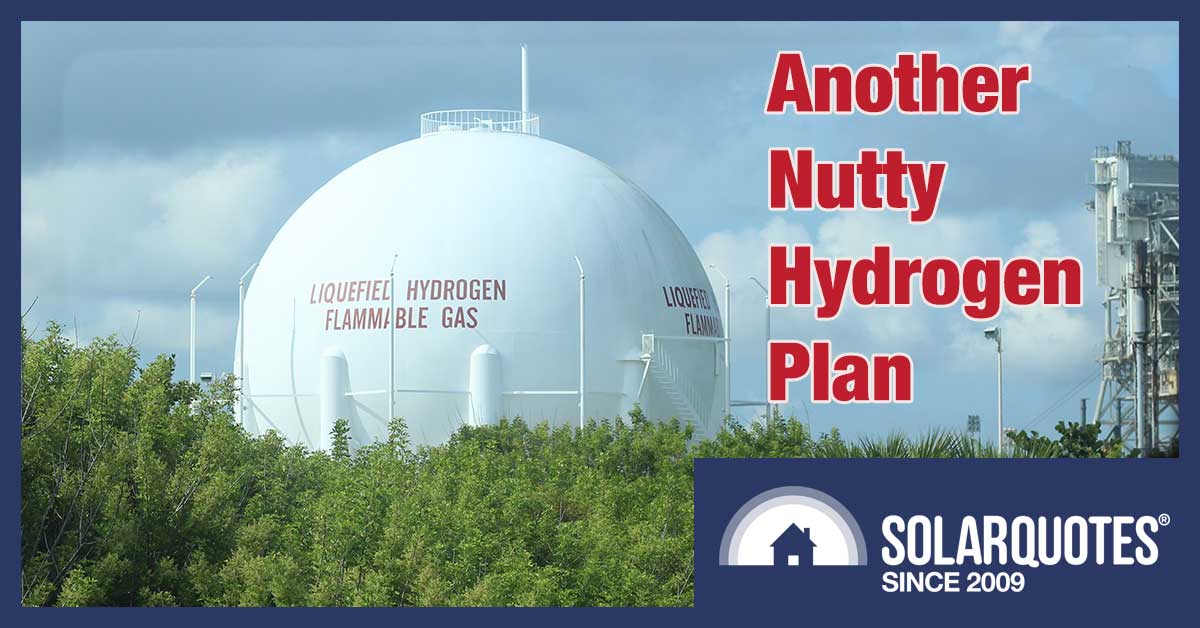
South Australian Labor clearly hope their new Hydrogen Plan can help them win back power in the March 2022 state election.
Will their huffing of hydrogen hype lift them higher than a zeppelin, or will it bomb?
Labor’s plan outlines how clean, green South Australian hydrogen will be…
- Produced
- Stored, and…
- Burned to generate electricity
The plan has a tight focus on burning hydrogen to generate electricity. Their goal is to build a hydrogen power station in South Australia.
In my opinion, this is a lousy idea that will only lose money. I’ll outline a better alternative, but first I’ll give details of their plan so you can decide for yourself if I’m full of hot air.
The Hydrogen Plan Nucleus
In a nutshell, SA Labor plans to spend $593 million to build 200 megawatts of dispatchable1 hydrogen generation. The fuel for this power plant will be produced and stored in South Australia. The plan also sells the vague hope of a hydrogen export industry years from now.
While it’s possible South Australia will export considerable quantities of hydrogen in the future, building a hydrogen power station that loses money isn’t a good way to increase the odds of that happening.
A Costly Project
You can read the hydrogen plan here. It won’t take long as there’s not a lot of detail in its 19 pages.
There are three parts:
- Electrolysers to produce hydrogen.
- Liquid hydrogen storage
- A hydrogen power station
This summary from the plan gives the cost of these components:
This is all scheduled to be completed by the end of 2025. So if State Labor — currently in opposition — wins the 2022 election, they’ll have around three and a half years to get the job done.
250 MW Of Bargain Basement Electrolysers
Electrolysers extract hydrogen from water, and enough of them will be built to draw 250 megawatts of power. The idea is they’ll operate when electricity is cheap.
Electrolysers can be 80% efficient. This means supplying them with 10 kilowatt-hours of electrical energy will produce hydrogen that will provide 8 kilowatt-hours of heat energy when burned. If hydrogen is used for electricity generation rather than just heat, there will be additional losses.
With a projected cost of $220 million, the electrolysers come to $880 per kilowatt. This is a lot better than the $1,000 a kilowatt figure that recently was considered optimistic for 2030. But at that price, I don’t expect them to be the highest efficiency electrolysers available.
A Crap Load Of Liquid Hydrogen Storage
Around $31 million will be spent on storage for 3,600 tonnes of liquid hydrogen. That seems cheap to me because it’s the sort of thing only space agencies have done before.2 Liquid hydrogen is not easy to produce or store. Hydrogen, whether liquid or gas, also embrittles many metals.
Liquid hydrogen is so light, one kilogram has a volume of 14 litres. This means 3,600 tonnes is 50 million litres. or 20 Olympic swimming pools. It’s also 34 times more than the hydrogen consumption of a space shuttle flight and 23 times what a Saturn V moon rocket required3.
While this will probably be more liquid hydrogen than anyone has ever had in one place, it’s still only 120 gigawatt-hours of thermal energy. This is 38% of the energy of the same volume of liquid natural gas (LNG). The world’s largest class of LNG tankers carry 194 times as much energy when fully loaded. (This is why they don’t allow smoking at Australia’s LNG export terminals.)
Liquification Efficiency
The highest possible efficiency for liquifying hydrogen is apparently 91%. But to keep the cost of the required equipment low, it’s more likely to be 77%.
If we assume a high efficiency of 80% for both electrolysis and liquification, then burning the liquid hydrogen will provide thermal energy equal to 64% of the electrical energy used to make the hydrogen. This means over one-third of the energy is lost by the time the hydrogen is stored in liquid form, and there will be further losses when it’s used to generate electricity.
If the hydrogen is stored for any length of time, there will be losses from refrigeration needed to keep it cold. These will be increased by the fact it sometimes gets warm in South Australia.
Enough For Two Months
If — including energy losses from liquifying the hydrogen — the electrolysers worked non-stop at 64% efficiency, it would take them 32 days to produce that much hydrogen. As SA Labor says, the 3,600 tonnes represents…
“…the equivalent of two months of hydrogen power generation.”
It suggests they expect the electrolysers to operate slightly over 50% of the time.
200 MW Hydrogen Power Station
There are two ways to generate electricity from hydrogen:
- Fuel cells, which are the opposite of electrolysers. They combine hydrogen with atmospheric oxygen to produce electricity and water.
- Burning it like natural gas.
While fuel cell efficiency can, technically, be fairly high, in reality, it’s typically around 50% or so. The Dutch fuel cell manufacturer Nedstack says they get 56% efficiency from theirs.
But the plan for SA is to burn the hydrogen in a Combined Cycle Turbine plant similar to many natural gas power stations. The efficiency of these typically ranges from 50-60%. Using liquid hydrogen can give a boost to efficiency due to its very low temperature. Still, the extra generation this allows isn’t free as a lot of energy has to go into liquifying it.
If the 200 megawatt hydrogen power station has 60% efficiency and operates non-stop, then 3,600 tonnes of stored hydrogen would be able to keep it operating for 15 days. If these figures are correct and 3,600 tonnes represents 2 months of hydrogen production, then the electrolysers will produce enough for the power station to operate at 25% of capacity, assuming it consumes all hydrogen produced. A 25% capacity factor is low, but not extremely so, for a small combined cycle gas power station.

I couldn’t find any good pictures of the first element, Hydrogen, so here’s one of the fifth element, Boron, who is clearly indicating Hydrogen by holding up one finger.
It’s An Expensive Power Station
At $342 million, the power station costs around $1,700 per kilowatt. That’s not cheap, but these days a conventional 200 megawatt combined-cycle natural gas power station would probably cost close to it. The fact it uses hydrogen rather than natural gas will add to the expense. This is because hydrogen is difficult to handle and, without precautions, will cause metal embrittlement, and that’s a bad thing to occur inside a huge turbine that spins 50 times per second.
These kinds of power stations have considerable operating costs even before fuel is included; for one this size, it may come to around 3 cents per kilowatt-hour generated. This report produced for the AEMO gives around 2.1 cents per kilowatt-hour for a considerably larger combined cycle gas power station operating at a much higher capacity factor, so we can expect the hydrogen power station’s cost per kilowatt-hour — not including fuel — to be considerably higher.
Hydrogen’s Horrible Efficiency
Lithium batteries can have a round trip efficiency of over 90%. That means if you charge one with 10 kilowatt-hours of electrical energy, you can get over 9 kilowatt-hours of electrical energy out.
Hydrogen-generated electricity has losses from:
- Electrolysing hydrogen
- Liquifying hydrogen
- Keeping liquid hydrogen cold while it’s stored and…
- Burning hydrogen in a combined cycle power station to generate electricity
SA Labor’s hydrogen energy storage plan’s overall round trip efficiency is likely to be 40% at best and is more likely to be under 35%. We will need more details than what the Hydrogen Plan provides to determine a precise figure.
Whichever way you look at it, having a total efficiency that at best is under half that of lithium batteries is lousy.
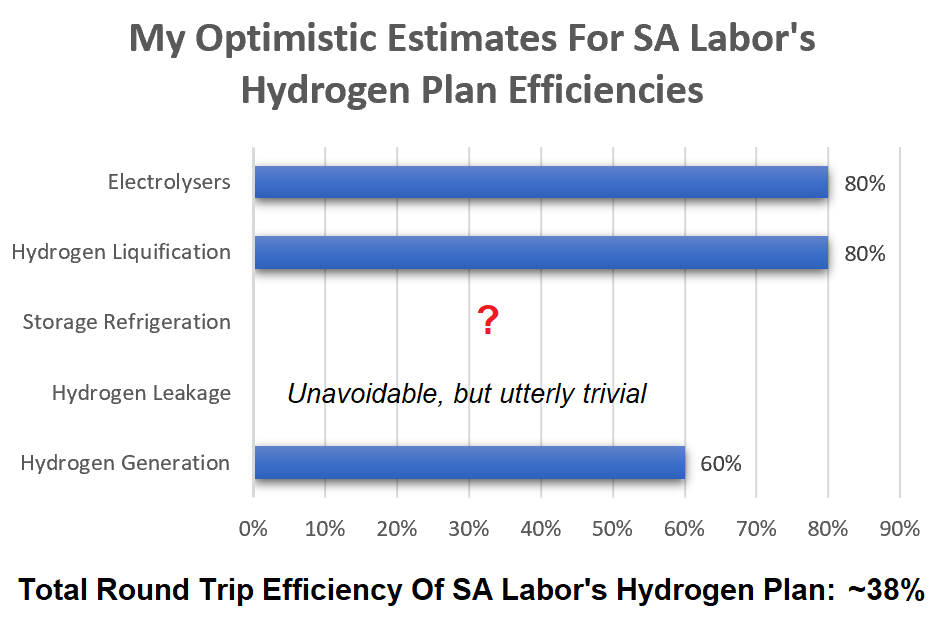
This graph gives my estimates for the various steps of the hydrogen plan. Ignoring the unknown losses from keeping up to 20 swimming pools of liquid hydrogen cold gives an overall efficiency of around 38%.
There Should Be Cheaper Alternatives
To sum up SA Labor’s Hydrogen Plan, in return for $593 million, South Australia will get a 200 megawatt power station that will operate around one-quarter of the time. Its fuel will be created using renewable energy but, at best, is only likely to supply 40% as much electrical energy as it consumes. This project is scheduled for completion towards the end of 2025.
This looks like a pretty awful plan to me because the cost of solar and wind generation and battery storage have been falling rapidly and are likely to be much cheaper by 2025. Battery packs for electric vehicles are now under $200 per kilowatt-hour. While there are other costs than just battery packs for large scale battery storage, I expect by 2025 it will be under $400 per kilowatt-hour.
It may be more cost-effective to instead use small scale battery storage in homes, businesses and vehicles. Still, to keep the comparison simple, I’m just going to look at large, utility-scale, big batteries.
Batteries Vs. Hydrogen
Assuming large scale battery storage is $400 per kilowatt-hour in 2025, rather than spending $593 million on SA Labor’s Hydrogen Plan, we could instead spend $560 million on 1,400 megawatt-hours of battery storage.4 This could…
- Supply far more power than the 200 megawatt hydrogen power station.
- When new, supply 200 megawatts of power for 7 hours. This is more than the average amount of energy the hydrogen power station appears able to supply per day.
- Have far lower operating costs than the hydrogen power station5.
Only being able to supply 200 megawatts for a maximum of 7 hours may seem pretty weak compared to the hydrogen power station that could supply 200 megawatts for hundreds of hours non-stop.
But I haven’t mentioned one major benefit of using batteries…
- There would be an extra 1,800 megawatt-hours of electricity supplied to the grid each day6.
This extra energy is thanks to the higher efficiency of batteries and it would…
- Lower wholesale electricity prices.
- Increase electricity exports.
- Reduce fossil fuel generation and associated greenhouse gas emissions.
- Reduce the amount of energy storage required.
- Lower the cost of charging batteries.
- Encourage the uptake of home and business energy storage.
- Encourage the use of electric vehicles.
- Encourage private enterprise to carry out energy-intensive processes in South Australia. This may include hydrogen production.
Using batteries instead of hydrogen generation would provide all the advantages shown in the following graphic:
The graphic is actually from SA Labor’s Hydrogen Plan. I just cut off the one point specific to hydrogen. However, honesty compels me to point out that “new jobs” does not mean “additional jobs”. Something politicians never seem eager to point out.7
Cheap Renewables Eliminate The Need For Long Term Storage
Their Hydrogen Plan makes it pretty clear to me SA Labor hasn’t cottoned onto the fact the low cost of renewable energy means long term energy storage is not required. Provided we have enough energy storage and hydroelectric capacity to get us through a night of low wind and either extreme cold or extreme heat, that’s pretty much all we need. This is because it’s cheaper to build additional solar power and wind generation — and let some of the energy go to waste — than it is to build energy storage.
Solar and wind output is variable but very reliable — especially solar energy. I can’t remember a single day the sun hasn’t come up8 or where clouds blotted all light from the sky. Building additional generating capacity will:
- Reduce the need for energy storage.
- Reduce electricity prices.
- Help keep the energy storage that does get built charged.
- Preserve water in existing hydroelectric dams so it will be available when most needed.
There is no need to have energy storage equal to months, weeks, or even days of electricity consumption.
Scrap At Least 58% Of The Plan
I’ve mentioned hydrogen may have many potential uses in industry, aviation, and shipping. But the case for hydrogen electricity generation in Australia is weak. It is just dumb for Australia’s flagship hydrogen project to focus on an obviously weak application that has an excellent chance of being a massive waste of money.
If SA Labor wants to promote hydrogen, they should instead spend our money on something that has a reasonable chance of bringing in more cash than it costs. For example, exporting any SA-made hydrogen to somewhere where hydrogen-generated electricity makes more sense.
To the north, there are 126 million Japanese people with a government that says they’re interested in importing Australian hydrogen. They can make better use of hydrogen electricity than we can because…
- There’s six times more of them.
- They have far less land per person with less renewable energy resources.
- It gets bloody cold in winter.
- They already import a lot of fossil fuels from us.
If SA Labor can’t convince Japan to import Australian made hydrogen for electricity generation, then that’s a bloody good sign it won’t benefit us here.
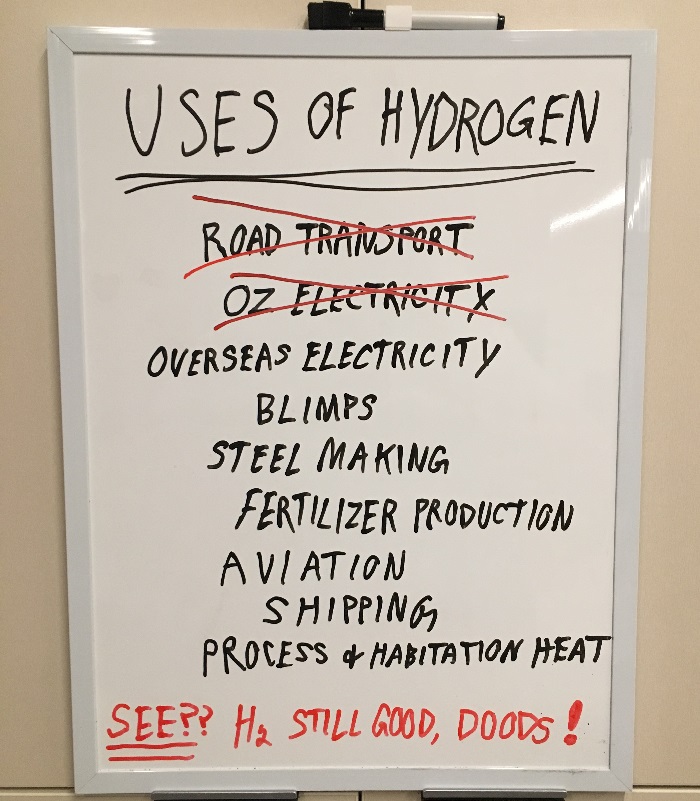
There’s still plenty of life in hydrogen. At least six more applications have to be crossed off before it goes to dead parrot land.
Footnotes
- Dispatchable power can be turned on when needed. Examples are coal, gas, hydro, pumped hydro, and batteries. Solar panels and wind turbines have variable outputs that depend on light or wind levels and so aren’t dispatchable. ↩
- Even Elon Musk — or rather Gwynne Shotwell — isn’t using hydrogen for SpaceX rockets. ↩
- When the Challenger shuttle exploded, around 92 tonnes of hydrogen were left in its external tank of the original 106 tonnes at launch. Despite using kerosene in its enormous first stage, the Saturn V moon rocket required even more liquid hydrogen at over 156 tonnes. ↩
- Update 31 March 2021: I originally wrote 13,000 megawatt-hours of battery storage instead of 1,400 megawatt-hours of battery storage. I apologize for my mistake. ↩
- While big batteries have operating costs, they are insignificant compared to those of a combined cycle gas power station. ↩
- Approximately, on average ↩
- Employment levels are, broadly speaking, determined by two main factors — the business cycle and structural factors. The majority of politicians don’t even know this, so it’s best not to believe them when they talk about jobs. ↩
- Finn can, but that’s what you’d expect from a Finn. ↩

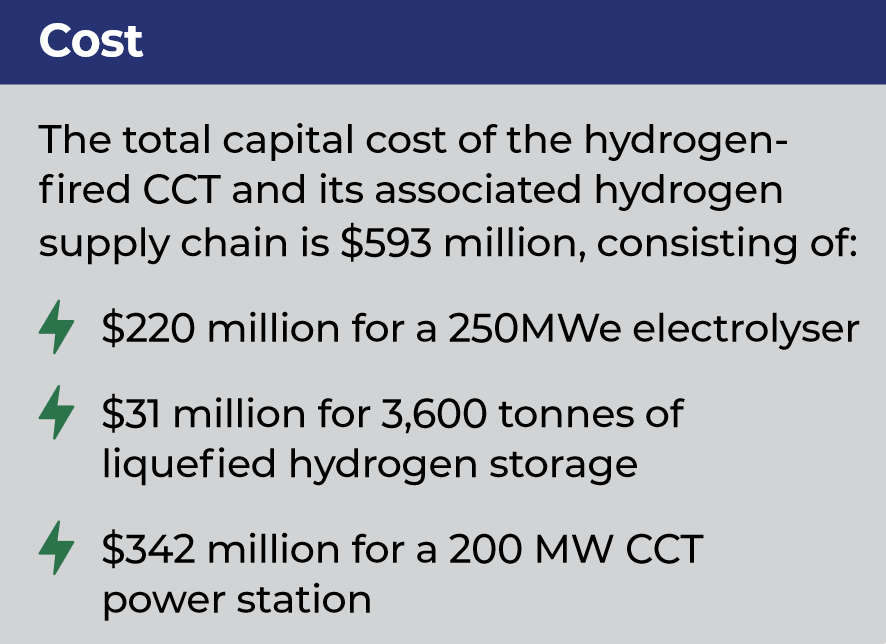
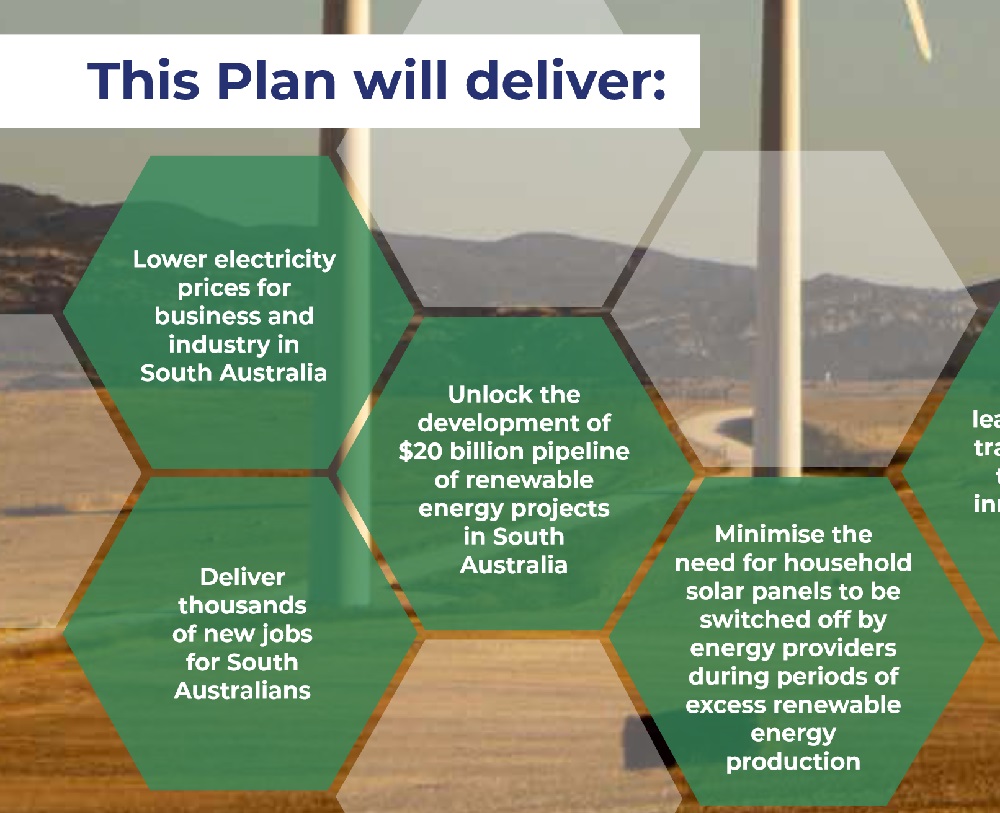
 RSS - Posts
RSS - Posts



>There is no need to have energy storage equal to months,
> weeks, or even days of electricity consumption.
Then why build batteries at all?
I think few days of consumption is bare minimum for batteries, and building inter-connector, and hopefully offshore line too.
And still build H2 production and storage for export for when the power cost negative or zero.
Why use batteries at all? Because using batteries to meet evening demand is cheaper than using fossil fuel generation and then sucking the CO2 released out of the air.
It’s cheaper even if we don’t remove the CO2.
Also, I think the Compressed Air Energy Storage is most viable solution, have not heard of it for a while – https://arena.gov.au/blog/compressed-air-storage-project-rises-from-old-mine/
Interesting to compare and contrast with HighView, https://highviewpower.com/, and the many pump hydro installations that could be built around the nation.
Please provide a description so people will know if the link is likely to interest them or not.
In this this case, Highview is a 50 MW 250 MW*h cryogenic storage system that stores energy using liquid air. By using waste heat they say it is able to be 70% efficient. Cost is unclear but a larger design apparently comes to around $1,800 per kilowatt of power output.
Yep, I meant that project. Though old mine would do as well if it’s handy..
You suggest the proposal is for a CCGT – but there are none (?) of these operating – Pelican Point (SA’s CCGT) has not operated for many years in closed cycle presumably because the steam plant is not economic when operated on a stop/start basis required of most gas turbine generators.
The correct firming power project is nuclear, using modern safe processes and processes that can cycle with load.
I meant there are many CCT gas power stations in the world and not dramatically different from what has been built many times before.
But your Pelican Point point does raise the good point of if a combined cycle gas power station — regardless of what kind of gas it burns — will be economical to run in South Australia.
Name a nuclear power station that has been cost effective over its complete cycle of design, construction, operation, decommissioning,waste storage and disposal. Provide links to the analysis. Ignore projections and budgets for unproven technology.
Nuclear is not the answer.
Did you comment in the right place, Paul? This hydrogen plan is 100% non-nuclear. It’s storing chemical energy from solar and wind generation.
Hydrogen stored as ammonia is more stable than liquid hydrogen with less boil off losses. I am not aware of the relative energy losses, ammonia production v hydrogen liquifaction. There is now proven technology for ammonia breakdown through catalysis to hydrogen then running through a PEM/alkali fuel cell, Gencell. It is wise to have a combination of technologies, batteries, electolysers to fuel cell generation and pumped hydro. The sun doesn’s always shine (rarely in OZ), the wind doesn’t always blow (rarely in OZ) but the rain doesn’t always fall (all too often in OZ), regardless of which technology is used, all have a part in the energy generation and storage mix. All systems degrade, lithium batteries are only able to supply 65% of their rated capacity at 10years, hydro has more than 25yrs, electrolysers and fuel cells ?.
Just in case anyone was thinking about heavy freight trucks and hydrogen… Trucks most certainly won’t run on hydrogen (embrittlement, engineering and infrastructure issues) especially when the average truck journey in Aus was about 158km. Even, that data was a bit skewed as most heavy freight vehicle journeys took place in metropolitan areas and were under 100km in length. Heavy freight vehicles will almost certainly run on batteries in the future. Long-distance inter-state trucks – I dunno. Maybe still diesel? Maybe ammonia? Maybe swappable batteries?
Shipping: the big problem for any exports of hydrogen (as per SA’s plan (above, as analysed by Ronald)) is that South Australia’s basically in the wrong place. Australia is, from an ocean shipping perspective, at the end of a cul-de-sac. Hydrogen is much more likely to be manufactured closer to the main intra-Asian, Asia-Europe and Trans-Pacific shipping routes. Hydrogen, for many of the reasons listed by Ron (above) is no sure thing in ocean shipping either. There seems to be a strong push for ammonia and / or methanol. Biofuel is looking like a realistic outsider and even wind on some very odd, niche trades. Small coastal trading ships can likely be run on batteries (there are pilot projects underway) and and near-shore / coastal marine craft (e.g. tugs) can be run on batteries.
For much the same reason, can’t see hydrogen taking off in aviation (pun-intended) much more likely to be biofuel or possibly ammonia.
Let’s face it, the way forward is to electrify as much as possible with solar, wind, various other forms where sensible (e.g. geothermal in NZ and Iceland etc), and heaps of battery storage and (possibly) off-river pumped-hydro (maybe, noting the extensive critiques published on Solar Quotes and elsewhere).
Heavy freight vehicles can be run (or mostly run) on ammonia. Where / when they can’t, there are biofuels and offsets (possibly). Hydrogen will probably have a use in steel-making and the making of ammonia.
You can cross a few more uses of hydrogen off your list Ron!
My job function is as power design engineer so as precarious as the whole debate and the technology driving all this hot air I would say this…hydrogen is not usefull for anything but just as the world is I say let these people with their huge pools of money get on wasting it on fluff…even if it’s governments they simply recoup the money by inflation so why worry. Solar as rife it is with causing harm during manufacture and recycle is just the price to pay to have power….and in the end no one wants to be stuck without power.
Besides a few flaws your article has here is a major….hydrogen from cheap power (just that will kill the stupid idea naturally) and a minor…turbines spinning at 50hz seriously? mechanical advantage always has to be geared to stay within a torque band so it will be anything but 50hz.
My bet for the power issue is local power on your roof and dumping it into storage….but there is still a price as no free lunch
Paul, I generally agree with your analysis of the problems and limitations of trying to solve the renewables storage problem with hydrogen, and the proposed scheme looks like a huge and expensive mistake.
But then you quickly just jump on the Lithium battery bandwagon, which whilst not as bad as the hydrogen proposal, are also a really bad investment.
Batteries will have a small part to play in a fully (or near to fully) renewables based grid, but even at a cost of $400 KW/h (which maybe very optimistic) they are still not economic for displacement of base load power generation, unless we accept a huge increase in power bills. Maybe you can provide a better answer, but at $400 kW/h over a lifecycle of 4000 charge/discharge cycles, the battery needs an average buy(charge) to sell(discharge) price difference of $100 MW/h, just to recover the capital cost. So we are back to sky high prices again…
Storage is the mamoth elephant in the room regarding renewables, and is an issue that just seems to be largely overlooked by the renewables at any cost zealots.
Note it is mainly the battery cells that wear out. Last year EV battery packs averaged around $178 per kilowatt-hour. If they fall in cost by 10% per year — about half the rate they have over the previous 7 years — they’ll be roughly $100 per kilowatt-hour in 2025. I would expect their eventual replacements to be considerably cheaper. (Other components of big battery storage will of course suffer wear, but generally less than the batteries.)
Hi Paul, please correct me if Im wrong, but in your haste to push the Lithium battery line, I think there is a mistake in your maths..
“Assuming large scale battery storage is $400 per kilowatt-hour in 2025, rather than spending $593 million on SA Labor’s Hydrogen Plan, we could instead spend $560 million on 13,000 megawatt-hours of battery storage. This could…”
I think $400 per kw/h = $400K per MW/h right?
That means $1M will buy you 2.5MW/H of storage
So $560M will buy you 560×2.5 = 1,400 MW/H of storage.
This is about 1/10th of the value you have quoted above.
Now looks very very expensive..
Hi Ronald. I came here to question your maths as Michael has outlined, but Michael has already done it. Are we missing something, or is there a mistake in your maths that needs correcting?
As much as I want batteries to be the cheap and cost effective answer to long term storage, and your $560M for 13GWh would seem to be a game changer on anything I had seen before, it seemed to be well outside of my understand of cost of batteries which make them a pretty poor performers in terms of costs for the long term storage requirements. I did the maths a little bit differently and based on your numbers calculated $43 / kWh which looked way too cheap for batteries at this stage??
Batteries do perform poorly on cost for long term energy storage. However, thanks to the low cost of renewable generation, long term energy storage won’t be required. See my point under the heading “Cheap Renewables Eliminate The Need For Long Term Storage” in the article.
My primary comment was be around how you did your calculation to come up with “…..rather than spending $593 million on SA Labor’s Hydrogen Plan, we could instead spend $560 million on 13,000 megawatt-hours of battery storage.”
That seems to be wrong by an order of magnitude of how many kWh you will get for your $560M, or is Michael and I missing something?
Sorry, I made a pretty big mistake in the article. I originally wrote “13,000 megawatt-hours of battery storage” instead of “1,400 megawatt-hours”. That was a very stupid mistake and while I’ve looked for someone to blame, the only person I’ve been able to find is myself. I apologize for the resulting confusion.
I have corrected the article and put a footnote in outlining the original mistake. Thanks for bringing my attention to it.
Sorry, I made a mistake in the article. I intended to write “1,400 megawatt-hours of battery storage” but instead put in a figure that was nearly 10 times larger. (I don’t know why.) The correct figure for my assumption is $400 per kilowatt-hour. I have corrected the article and put in a footnote explaining the original error.
Thanks for bringing my attention to it.
How does the operating lifetime play into the equation??
Does the proposed hydrogen plan have a 30 year lifetime vs 10 years for battery storage?? I’m making these numbers up as examples, but I wonder if thats part of whats missing from the analysis that makes the hydrogen option look less than ideal….
Your next task Ron is to convert your report into words not exceeding one syllable each, changing type face to 24 point Courier, printing out multiple copies and presenting them to the Chiefs of staff of each proponent politician (or candidate) in order for them to read slowly to the subject pollies.
Advise the pollies there will be a simple exam on completion to ensure they put their phones down for the duration.
Good luck !!!
How is hydrogen measured by weight, since it’s so low in density it just rises up through the atmosphere into space?
The specific gravity of:
Air, dry 0.0013 Kg per cubic meter
Hydrogen 0.00009 ditto.
Hydrogen ought to be measured in anti-kilograms per cubic meter?
Just saying.
I’m puzzled. Where’s the technical justification for needing 200 MW for “…the equivalent of two months of hydrogen power generation”? Why does SA need circa 1440 hours (288 GWh) of continuous duration? Is SA Labor expecting inadequate wind and solar generation to meet demand in SA at some times for that duration? Where’s the hour-by-hour capacity vs demand over many years data to back that premise?
Why adopt the SA Labor’s hydrogen CCT generator plan when the round trip efficiency is apparently circa 38%? IMO, that’s woeful compared with some other dispatchable alternatives. And what’s the operating life of this equipment – 30 years?
Pumped-hydro round trip efficiency varies from 70 to 80% (site dependent), with an operating life of 100+ years. It’s not as if SA is devoid of pumped-hydro sites – potentially up to 500 GWh. I’d suggest pumped-hydro is a more cost-competitive technology for multi-day continuous duration.
https://arena.gov.au/projects/atlas-pumped-hydro-energy-storage/
But then again, why let these key technical and economic considerations get in the way of politicking?
And they’ll still get it wrong.
There ain’t none so blind as those that refuse to see.
“Provided we have enough energy storage and hydroelectric capacity to get us through a night of low wind and either extreme cold or extreme heat, that’s pretty much all we need”. How are you sure about that? It might be that we need some bulk storage to account for energy supply and demand cycles that exist beyond the horizon of a day or two. What if it’s like you said but for two or three nights in a row, or even a week, with calm, overcast days? Supply and demand cycles in the energy market aren’t restricted by nature to the 24h day and night cycle.
Hi Sean
I’m sure about that — provided we have extra renewable generating capacity that enables us to limit the amount of battery storage required and preserve water levels in hydroelectric dams for when it is most needed.
Australia’s hydroelectricity capacity is pretty unique in the world with it’s high power to energy ratio. During a period with days of high demand and low renewable generation we would run hydroelectric capacity almost non-stop and use it to charge battery storage during dips in demand. (Note we’re not going to get rid of existing gas and diesel generation until we’re sure it’s no longer needed, so that will still be around to contribute for a considerable time.)
So the discussion is hydro vs hydrogen, not hydrogen vs batteries. Hydro is not as efficient as batteries either, and is more restricted than hydrogen in terms of where it can be installed, ie you need specific topography.
That’s existing hydro electric capacity already in place, not new capacity. There are no good locations left in Australia for conventional hydropower schemes.
Sean,
There has already been an exploration of the various dispatchable renewable energy options in an ARENA commissioned 2018 report titled “Comparison of Dispatchable Renewable Electricity Options”. I’d suggest you look at the graph titled “Ranges of Competitiveness” on page VI.
https://arena.gov.au/knowledge-bank/comparison-of-dispatchable-renewable-electricity-options/
Off-river pumped-hydro systems have turn around energy efficiency of 70 to 80% (site dependent), with an operational life of 100+ years, with minimal degradation in capacity. Cost-competitiveness is in the multi-hour to multi-day duration range. Ramp up times from standby are of the order of 90 seconds to a few minutes.
Battery energy storage systems (BESSs) have a turn around energy efficiency of the order of 90%, with an operational life up to 20 years, with significant capacity degradation. Cost-competitiveness is in the low multi-hour duration range. Ramp times are in hundreds of milliseconds.
Hydrogen CCT systems have a turn around energy efficiency of the order of 34%, with an operational life of circa 30 years. Cost-competitiveness is potentially in the 50+ hour duration range (but it seems to me there are perhaps optimistic assumptions about this apparently relatively new technology). Ramp up times from standby are probably of the order of minutes.
Hydrogen (H2) is very difficult to contain – ammonia (NH3) is an easier to contain energy storage medium.
I recommend watching the YouTube video titled “100% Renewable Energy solar/wind with pumped Hydro with Professor Andrew Blakers of Australia ANU”, duration 1:43:14, published 24 Feb 2021.
Depending on how far away you are from a hydro site, the transmission losses from that site may reduce the overall efficiency to below the efficiency of a more local hydrogen facility. Also efficiency (particularly during the storage operation) isn’t that important when you have cheap or negative price supply. Been seeing wholesale prices go negative frequently because of oversupply, particulary on sunny days in QLD.
Sean,
High voltage transmission losses are only a few percent. You would need transmission losses of around 29% each way for PHES for the overall efficiency to be worse than for hydrogen with no transmission losses – I’d suggest your scenario is simply not going to happen.
Poor energy efficiency means more primary energy generating capacity (more wind and/or solar-PV) required. Hydrogen energy efficiency is so poor more than double the energy input is required compared with PHES for the equivalent output, and more than 2.6 times compared with batteries. PHES also has a very substantial longevity. So, PHES needs less generating capacity and lasts much longer – means less whole-of-life costs.
IMO, the data indicates there isn’t a good case for hydrogen for grid electricity generation.
Hydrogen for aviation At some height hydrogen becomes a GHG by combining with oxygen and existing as water vapour. Does this limit the height at which aircraft could operate or do planes fly well below this height? Will this limit planes to flying uneconomically low so the water vapour will be removed by rain?
On a different tack isn’t it obvious that any hydrogen generation should be as close to the equator as possible except where there is a local use such as reducing iron ore to iron where it might be best close to either the market or the source of the ore. Generating hydrogen south of the tropic of capricorn will involve higher capital costs and, as mentioned, higher costs for any export.
If the export trade matures the cost of shipping should come down to about the same as bulk ore or coal, around USD10to20 per tonne which is probably a lot of energy per dollar. I think the Capital and operating costs will always be higher the further you are away from the sun. So what advantage does South Australia or Victoria have over Indonesia or China? We might find its cheaper to buy Chinese hydrogen than use our own sunshine.
I think I got the issue wrong in relation to specific density or specific gravity…
But in having become a scientist of great and world famous renoun, with dads beer bottle, some hydrochloric acid, zink and a balloon, the trip to outer space and the other planets has left me somewhat overwhelmed.
So why is plain hydrogen gas, not measured in antikilograms?
It makes sense to me.